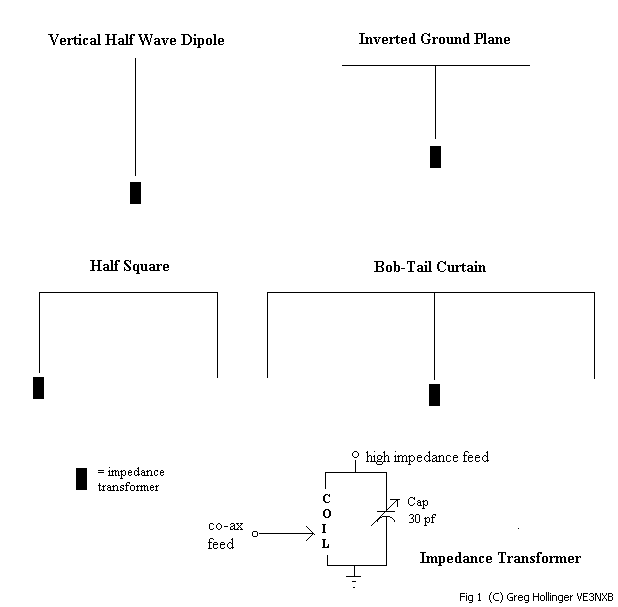|
 |
BIG BANG
HF Wire Antennas for
Field Day or Any Day
<C> 2004 Greg Hollinger VE3NXB |
 |
|
Greg VE3NXB |
Having used simple wire dipoles and verticals for many years, I have
found that too many of my great expectations were in reality, just duds.
As I get wiser... well hopefully, I realize that some well worn antenna
configurations are the easiest and loudest lash-ups tried so far.
Strangely, few antenna gurus tell the whole story, but that has changed
of late.
OK, so what's so great about this antenna? Well actually a family of
antennas were you pick the configuration that suits your immediate need,
like field day, or QRP at the campground.
How about:
-
easy hang from one or two tree limbs or supports
-
same DX performance as a dipole at twice the height
-
little of the ground loss inherent in the popular low impedance fed
vertical and no extensive ground radial system required
-
gain similar to a two, maybe even a three element yagi
-
very inexpensive to put together
OK, now what's the down side?
-
you have to build a simple impedance transformer to drive it
-
single band, unless you get creative
-
unlike the yagi, very difficult to rotate
In a nutshell, each antenna is an end fed (high impedance) wire of at
least one-half wavelength and configured as a vertical dipole, inverted
ground plane, half square, or bobtail curtain. They all use the same
parallel resonant impedance transformer to create about 4,000 ohms at
the feed point.
The vertical dipole or inverted ground plane has an omni-direction
pattern, low take off angle, and low loss.
The half square or bobtail, has bi-directional broadside gain with
pattern nulls in the opposite directions.
The impedance transformer usually rests on the ground where it connects
to the co-ax feed line and an end of the antenna wire (see figure).
Ground the co-ax shield to a short ground stake at this point.
You can achieve the bang of a horizontal dipole at a one half wavelength
height (required for low angle DX performance), at half the physical
height when you configure your wire as a half square. But, if you have
the space, add more wire (remember, same physical height) and make a
bobtail. The pattern azimuth curves narrow, the nulls off the horizontal
ends deepen, and the broadside gain jumps.
An impedance transformer set to resonance drives any of these antennas.
I made mine from 10.5 feet (3.25m)of 12 AWG solid copper bare wire. Make
the coil inside diameter about 1.5 inches (4cm). Evenly space windings
the width of the wire. For low power operation, almost any air variable
capacitor of at least 30 pf can be used to resonate on the 30 or 20
meter band. The 50 ohm co-ax tap will be found at approximately one
quarter of the total number of turns as measured from the bottom. Too
keep mine dry, I mounted the circuit in an inverted plastic ice cream
container with the snap-on lid screwed to a wooden plank for stability.
The plank and the co-ax rest on or at ground level.

To create a "no tune" installation at your site, pre-resonate the
transformer on the bench. Temporarily place a 4 to 4.5 K ohm, one watt
or greater carbon resistor between the top and bottom of the coil. This
is a dummy load. Connect an antenna analyzer to the co-ax feed point.
Set your frequency on the analyzer and adjust the capacitor for minimum
SWR, then adjust the tap point for 1:1. When you finish your antenna
installation, the transformer will still show a nicely matched impedance
on the co-ax. If not, you measured your wire incorrectly. Note that the
very high impedance at the top of the coil will vary considerably if
your hand, metal, or something like a tree branch comes close. Using
moderate to high power creates very high RF voltage, so protect people
and animals from contact.
To determine length for 12 AWG insulated wire, use the following
formulas:
-
Vertical dipole 468/freq. in MHz
-
Inverted ground plane 468/freq. for the horizontal wire, 253/freq. for
the vertical wire
-
Half square and bob tail 450/freq. horizontal, 260/freq. vertical
The formulas differ from the norm for the half square and bobtail to
maintain a close match to the impedance transformer and be somewhat
inductive. This positions the array for optimum gain as described by
L. B. Cebik, W4RNL in his article, "Power and Antenna Gain on 60
Meters" that appears on page 36 of the February, 2004 issue of QST
magazine. Although Cebik presents his antenna data using the new
American 60 meter band, it is applicable to all. Here you will also find
gain figures and comparisons for these antennas. His work illustrates
the performance achievable.
Over the past ten years or so, I have used all of these easy to assemble
wire antennas and made many transformer circuits. You will find that one
transformer design may be adjusted for resonance on 2 adjacent amateur
bands. I currently have a 30 meter vertical dipole in the back yard.
When I find the best positioned tree branches, I will expand it into a
half square with one of the 3.41 db gain lobes (referenced to the
dipole) directed towards Europe. If I had the space, a bobtail would
have 4.91 db gain, but make positioning more critical. As it stands,
this vertical outperforms my ground mounted Butternut HF6V which has
good 30 meter DX 'ability.
To sum-up
If you are using an inefficient antenna, like a ground mount
vertical, but looking for better performance; a small half square
mono-band wire array, may be the coolest BIG BANG - HF fireworks
display.
Oh, almost forgot... I mentioned being creative earlier. Here is one way
to make the wire do more.
A 20 meter half square will function as a low 40 meter horizontal dipole
with the ends folded down. Using an impedance transformer resonant on 40
meters, the dipole will produce mostly omni-directional vertical
radiation and work nicely for contacts out to 500 miles (800km)or so.
Special thanks to Don, VE3ESE for his input and helpful suggestions.
73 es DX, Greg VE3NXB
e-mail to ve3nxb @ kwarc.org
Go back to the home page KW Amateur Radio Club Inc.
|


